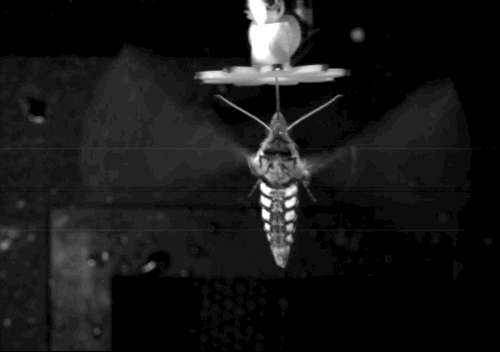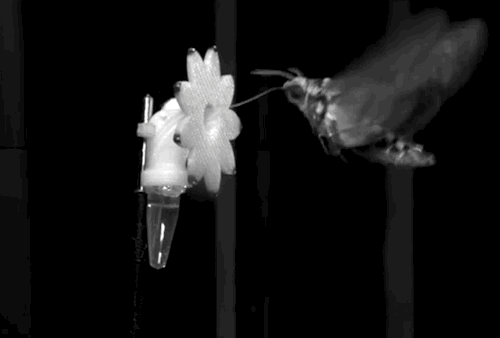Hovering Hawkmoths Slow Down Their Brains to See in the Dark
The insects’ night vision appears to be finely tuned to the movement of their flower food sources
/https://tf-cmsv2-smithsonianmag-media.s3.amazonaws.com/filer/d3/b7/d3b71417-e2f6-492f-8b81-bf60354d3d92/sponberg2hr_edit.jpg)
Finding food in the dark requires some skill, especially if you’re a hawkmoth. These insects slurp flower nectar with a long mouthpart akin to a giant bendy straw—all while hovering in midair as their food sources sway in the breeze.
“Doing all of that in light levels where I wouldn’t be able to see the hand in front of my face, that’s a pretty remarkable behavior for an animal with a brain much smaller than a pea,” says Simon Sponberg, a neuromechanist at Georgia Tech. Now, Sponberg and his colleagues have found that hawkmoths have adopted an unusual trick to achieve such a feat of the senses: Under low light conditions, the insects can actually slow down the way their brains process light. While this comes at a cost—a slower reaction time—the insects mostly feed on flowers that move at just the right speed.
“They actually avoid a trade-off, because they get the additional sensitivity of slowing down their visual systems, but they don’t slow it down to where they would do really poorly at tracking the natural flowers that they care about,” explains Sponberg. “They’re very attuned to their environment.”
Hawkmoths have compound eyes made up of facets called ommatidia. These are covered in sheaths that bend specific wavelengths of light to hit small bundles of visual nerve cells, which then send signals to the brain. The brain compiles a mosaic from the wealth of signals to create an image. In the dark, the sheath pulls back, and the eye absorbs as many wavelengths of light as possible.
“The mechanism is different, but the effect is sort of like widening the aperture of a camera," says Sponberg. "It collects light over a larger region of space,” making for a brighter picture. However, this effect is not enough to let the moth truly see in the dark. “It allows the moths to see about a thousand times better than they would normally be able to see in terms of light sensitivity. But that’s way insufficient for being able to see at night,” says Sponberg.
Some neuroscientists had suggested that the insects, which do most of their feeding at dusk, might actually be slowing down their light perception—a bit like slowing the shutter speed on a camera to expose an image longer. “The animal would integrate light for a longer period of time so that it could collect more light and be more sensitive to dimly lit objects,” says Sponberg.
To investigate, Sponberg’s lab built robotic flowers that could sway at controlled speeds. The team monitored how hawkmoths responded to flowers moving at different speeds and in varying light levels. By calculating the insects' reaction times, the researchers saw that the moth motions matched up with mathematical models of slower brain processing. On average, the moths responded to floral motion 17 percent slower in the dark. The moths’ ability to track the swaying flowers seemed to cap at 2 Hertz, or two sways per second. Anything higher and they missed their target, the team reports today in Science.

The researchers aren’t exactly sure which neurons are slowing down in the insects' brains. The moths aren’t changing the way they move, though, so the speed adjustments must be happening in the part of the brain that controls vision. “It’s not just how fast they can see, it’s how fast they can accelerate back and forth—the combination of both the physics of their brain and the physics of their body,” says Sponberg.
So is the moths' speed limit arbitrary, or does it have actual implications in the wild? The team selected flowers frequented by hawkmoths. Outside, they recorded videos of the flowers moving and tracked their speed. Flowers don’t just sway at a nice, steady speed. However, the team found that whether they were blowing to one side or moving back and forth, the flowers weren’t moving faster than 2 Hertz at least 90 percent of the time.

When these moths slurp up nectar, they also pollinate the plant. In the pollination game, the sights and smells of certain plants have often evolved to be finely tuned to the senses of their preferred pollinator. The new work suggests that motion may be just as coordinated. But whether it's the flower or the insect that sets limits on this relationship remains unclear. “It would be difficult to prove, either way,” notes Eric Warrant, a zoologist at Lund University in Sweden, who also wrote a perspective piece on the study.
Down the line, understanding hawkmoth vision and flight could have applications in robotics, notes Noah Cowan, an engineer at Johns Hopkins University. The findings could “provide clues as to how to build a better control system or flight system,” he explains.
And from a basic biology perspective, “the fact that the moths slow down just enough to still respond to the speed of moving flowers is really cool, and it shows how well the moth brain is adapted to its environment,” adds Jessica Fox, a neuroscientist at Case Western Reserve who was not affiliated with the study. Plenty of other insects have to navigate diverse light environments—from fruit flies to nocturnal bees and wasps. While these bugs might not have adapted their visual processing in exactly the same way, it’s possible that other animals employ similar strategies.
“The hawkmoth is the first animal in which we've seen this strategy," says Fox, "but I bet it won't be the last.”
/https://tf-cmsv2-smithsonianmag-media.s3.amazonaws.com/accounts/headshot/Screen_Shot_2014-01-27_at_12.05.16_PM.png)
/https://tf-cmsv2-smithsonianmag-media.s3.amazonaws.com/accounts/headshot/Screen_Shot_2014-01-27_at_12.05.16_PM.png)